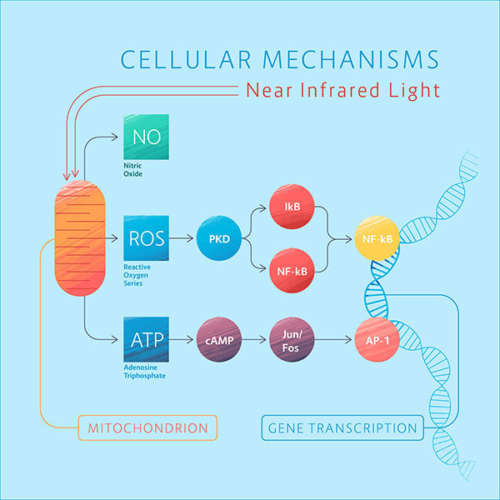
Photobiomodulation therapy is defined as the utilization of non-ionizing electromagnetic energy to trigger photochemical changes within cellular structures that are receptive to photons. Mitochondria is particularly receptive to this process. At the cellular level, visible red and near infrared light (NIR) energy are absorbed by mitochondria, which perform the function of producing cellular energy called “ATP”. The key to this entire process is a mitochondrial enzyme called cytochrome oxidase c, a chromophore, which accepts photonic energy of specific wavelengths when functioning below par.
Photobiology is the study of the effects of non-ionizing radiation on biological systems. The biological effect varies with the wavelength region of the radiation. The radiation is absorbed by molecules in skin such as DNA, protein or certain drugs. The molecules are changed chemically into products that initiate biochemical responses in the cells.
Biological reaction to light is nothing new, there are numerous examples of light induced photochemical reactions in biological systems. Vitamin D synthesis in our skin is an example of a photochemical reaction. The power density of sunlight is only 105 mW/cm2 yet when ultraviolet B (UVB) rays strikes our skin, it converts a universally present form of cholesterol, 7-dehydrocholesterol to vitamin D3. We normally experience this through our eyes which are obviously photosensitive. Our vision is based upon light hitting our retinas and creating a chemical reaction that allows us to see. Throughout the course of evolution, photons have played a vital role in photo-chemically energizing certain cells.
Pathways
- NO (Nitric Oxide)
- ROS (Reactive Oxygen Series) → PKD (gene) → IkB (Inhibitor κB) + NF-κB (nuclear factor κB) → NF-κB (nuclear factor κB stimulates gene transcription)
- ATP (Adenosine Triphosphate) → cAMP (catabolite activator protein) → Jun/Fos (oncogenic transcription factors) → AP-1 (activator protein transcription factor stimulates gene transcription)
The currently accepted science is that low level visible red to near infrared light (NIR) energy is absorbed by mitochondria and converted into ATP for cellular use. In addition, the process creates mild oxidants (ROS), which leads to gene transcription and then to cellular repair and healing. The process also unclogs the chain that has been clogged by nitric oxide (NO).The nitric oxide is then released back into the system. Nitric oxide is a molecule that our body produces to help its 50 trillion cells communicate with each other. This communication happens by transmission of signals throughout the entire body. Additionally, nitric oxide helps to dilate the blood vessels and improve blood circulation.
Near-infrared light (NIR) stimulates mitochondrial respiration in neurons by donating photons that are absorbed by cytochrome oxidase. This is a bioenergetics process called photoneuromodulation in nervous tissue. The absorption of luminous energy by the enzyme results in increased brain cytochrome oxidase enzymatic activity and oxygen consumption. Since the enzymatic reaction catalyzed by cytochrome oxidase is the reduction of oxygen to water, acceleration of cytochrome oxidase catalytic activity directly causes an increase in cellular oxygen consumption. Increased oxygen consumption by nerve cells is coupled to oxidative phosphorylation. Hence, ATP production increases as a consequence of the metabolic action of near-infrared light. This type of luminous energy can enter brain mitochondria transcranially and independently of the electrons derived from food substrates, therefore it can directly photostimulate cytochrome oxidase activity.

